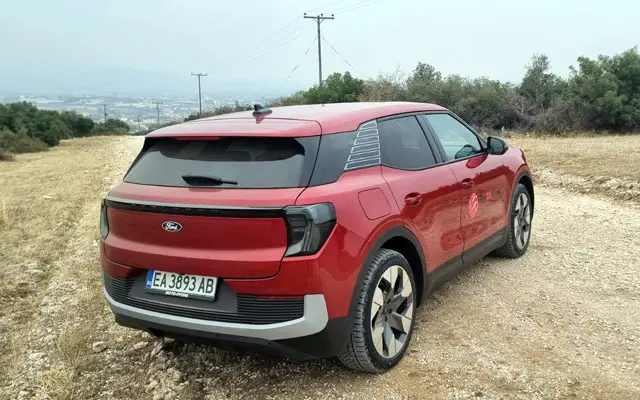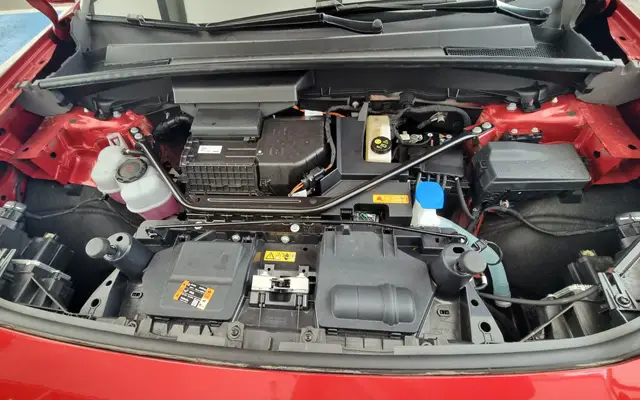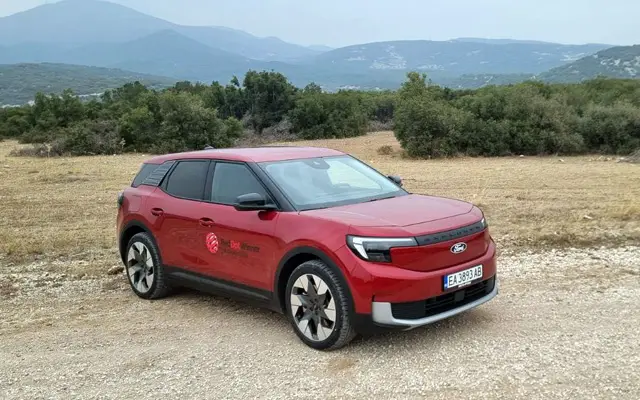Since its design, the electric SUV Ford Explorer has had a close relationship with the Volkswagen ID.4, as the two models share the same platform and, as expected, have a similar target audience. As a result, they are often compared to each other, but since we have driven both models, we can safely say that in reality these two electric vehicles have as many differences as similarities.
For starters, the new Explorer is made by Ford, not VW. Designed and engineered in Europe for Europe, it is produced at the brand's Cologne factory, which has produced 18 million Fords since 1930, but now, after a two billion euro renovation, is a specialized electric vehicle factory powered by renewable energy and making extensive use of robots with artificial intelligence.

The new electric Explorer has already entered the domestic market, and our team decided to test its capabilities. In principle, as you may well know, we are not big fans of electric cars, not so much because of the still imperfect technology in them, but because of the insufficient infrastructure and their excessively high prices. Nevertheless, we liked the Explorer, at least because we reached the sea without stopping to charge. Here is what we are talking about.
Exterior
The Explorer is styled as a modern SUV, with hints of the larger non-electric American Explorer. Although this car has a lot in common under its "skin" with the ID. 4, the appearance is quite different. In addition to looking rougher in the good sense of the word, it has 120 mm removed from the rear overhang, which somewhat reduces its luggage space, but at the same time ensures that it is of a clearly different size and shape than the other electric car of the "Blue Oval" - Mustang Mach-E.

Specifications
You can get the Explorer with rear-wheel drive or all-wheel drive. For now, all rear-wheel drive versions are billed as Extended Range, which means a 77kWh (net) battery. There will also be a smaller one, with a capacity of 52 kWh. Rear-wheel drive includes a single electric motor, while all-wheel drive adds a front electric motor. engine, but both versions have a single-speed gearbox.
Official WLTP data shows that the rear-wheel drive car with a power of 77 kWh can travel 602 kilometers, and the four-wheel drive version, or AWD Premium, with the largest 79 kWh battery, should travel 530 kilometers. We tested a version with rear-wheel drive and a large battery.

The engine of the extended-range version with rear-wheel drive has a power of 286 hp. and can accelerate from 0 to 100 km/h in 6.4 seconds. The system output of the two-motor variant is 340 hp, with acceleration from a standstill being slightly better at 5.3 seconds. The electric Explorer uses new lithium-ion NMC batteries with a claimed charging time of 28 minutes from 10 to 80 percent for a fast charger.
Interior
Get into the Explorer and you are firmly in the territory of compact family SUVs. If you are looking for an electric vehicle with increased cross-country ability, you have definitely come to the right place. Those of you who have touched an electric Volkswagen cannot help but notice the similarities in some of the instruments on the dashboard. Some aspects of the cabin look and feel familiar, but Ford, as we've already mentioned, has made changes both outside and inside.

The interior impresses with a fresh, modern design that goes beyond VW's vision. With its technological simplicity, the Explorer looks towards Tesla/Hyundai/Kia territory. The car is only a few centimeters longer than the Focus, but there is a lot more space in the cabin, which is more like a Mondeo or Kuga. As for the instruments on the dashboard, we were impressed by the new 14.6-inch central touchscreen, which moves vertically for optimal visibility and at the same time reveals a small space for items behind it.
The materials are of relatively high quality, but do not impress with excessive luxury. What is a plus is the very good assembly of the details in the cabin. Otherwise, like its VW cousins, the Explorer comes with an extensive set of sensors and cameras that allow for operation with assistance systems, including cross-traffic warning with active braking, intelligent adaptive cruise control and lane keeping assist. Overall, the interior is modern, functional and spacious, and the trunk with its just over 400 liters is (let's say) sufficient.

Engine and handling
The bigger changes, and very welcome ones, are in the way this car rides and handles. The things Ford modifies are all changes for the better: the steering, the shock absorbers, the anti-roll bars. Our RWD test car performed excellently on the highway, in city traffic, and on roads with many bends. In other words, this car has a fairly balanced ride, which tends to be soft, but without serious body roll in corners due to its low overall center of gravity. This Ford is far better controlled and has a more rewarding precise steering feel than its VW counterpart.
But the ride is not perfect: without an internal combustion engine and with supposedly improved noise insulation (so Ford claims), the car has a hard time muffling the sound coming from the road at highway speeds. Otherwise, there is no aerodynamic noise and in general one feels quite comfortable. But let's get back to where we started. Did this car reach the sea without recharging? The short and precise answer is yes, but there are some nuances.

First, we traveled not to our native Black Sea coast, but to the Greek White Sea, and more specifically from Sofia to Thessaloniki, and secondly - we finished with a remaining charge for 76 kilometers, that is, "by magic". The road, which you are well aware of, is 300 kilometers long, starting on the "Struma" highway we drove on the edge of what was allowed - at 140 km/h. The second stage, through "Kresna" to the border, we drove at a normal speed (as far as the road allows), but from Kulata to Thessaloniki we started to save energy. It got to the point that in the end we were driving behind a truck (supposedly for better aerodynamics) and at a speed of 70 km/h. But we managed.
During this interesting trip, we realized that switching driving modes makes a noticeable difference in the level of brake energy recuperation. In normal, when you lift the gas, the car slows down; in Sport it slows down a lot; in Eco not so much. There is also a "B" setting on the short gear selector on the steering column, which feeds additional electricity into the battery.

Conclusion and price
In conclusion, we will say that the WLTP consumption is not indicative, but this applies to all electric vehicles, but on the other hand the car feels excellent. This is a "smooth" and comfortable family SUV, without being luxurious or too sophisticated and calmly covering 250 kilometers without saving any energy. The Explorer may be a bit behind in terms of trunk space, but it's a more enjoyable drive than most of its direct competitors.
Why the Explorer and not the Mustang Mach-E, for example? The Explorer is a bit taller, not as long, and has the right SUV shape and optimal dimensions for a compact SUV, while the Mach-E is a strange crossover (pony mash), which makes it more of a rival to the equally illogical ID. 5, although objectively they are all fighting for roughly the same market share and are on the same level. Here the best option for us (from the above) is the Explorer.

But we shouldn't praise it too much, at least until we compare it with its Korean competitors. But driven in isolation, the Explorer is a very impressive electric vehicle that is good to drive, intelligent, well-equipped and competitively priced. The latter is not cheap at all and currently starts at 105,700 leva for the rear-wheel drive and extended-range Premium version, which we drove. The base variant, however, starts at 85,900 leva, which, given its positioning, is somewhere below the "golden mean".
Pros: Solid appearance, good ride and handling, spacious interior
Disadvantages: Some cheap-feeling materials in the interior, more modest trunk, poor noise insulation from the road at high speed.
